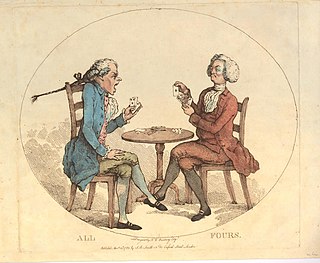
All fours is a traditional English card game, once popular in pubs and taverns as well as among the gentry, that flourished as a gambling game until the end of the 19th century. It is a trick-taking card game that was originally designed for two players, but developed variants for more players. According to Charles Cotton, the game originated in Kent, but spread to the whole of England and eventually abroad. It is the eponymous and earliest recorded game of a family that flourished most in 19th century North America and whose progeny include pitch, pedro and cinch, games that even competed with poker and euchre. Nowadays the original game is especially popular in Trinidad and Tobago, but regional variants have also survived in England. The game's "great mark of distinction" is that it gave the name 'jack' to the card previously known as the knave.

Basset, also known as barbacole and hocca, is a gambling game using cards, that was considered one of the most polite. It was intended for persons of the highest rank because of the great losses or gains that might be accrued by players.
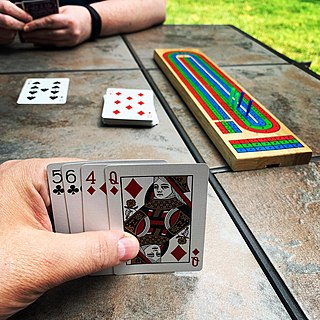
Cribbage, or crib, is a card game, traditionally for two players, that involves playing and grouping cards in combinations which gain points. It can be adapted for three or four players.

Brag is an 18th century British card game, and the British national representative of the vying or "bluffing" family of gambling games. It is a descendant of the Elizabethan game of Primero and one of the several ancestors to poker, the modern version just varying in betting style and hand rankings. It has been described as the "longest-standing British representative of the Poker family."

Ombre or l'Hombre is a fast-moving seventeenth-century trick-taking card game for three players and "the most successful card game ever invented."
Ruff and Honours, Ruffe and Trump or Slamm was an English trick-taking card game that was popular in the 16th and 17th centuries; it was superseded in the 18th century by Whist.

Post and Pair or Post and Pare is a gambling card game that was popular in England in the 16th and 17th centuries — another name of the game was Pink. It is based on the same three-card combinations, namely prial, found in related games of this family.

Twenty-five is the Irish national card game, which also underlies the Canadian game of Forty-fives. Charles Cotton describes its ancestor in 1674 as "Five Cards", and gives the nickname five fingers to the Five of Trumps extracted from the fact that the Irish word cúig means both 'five' and 'trick'. It is supposed to be of great antiquity, and widely believed to have originated in Ireland, although "its venerable ancestor", Maw, of which James I of England was very fond, is a Scottish game.

Patience (Europe), card solitaire or solitaire (US/Canada), is a genre of card games whose common feature is that the aim is to arrange the cards in some systematic order or, in a few cases, to pair them off in order to discard them. Most are intended for play by a single player, but there are also "excellent games of patience for two or more players".
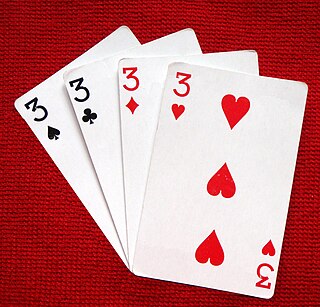
Put, occasionally Putt, is an English tavern game first recorded in the 16th century and later castigated by 17th century moralists as one of ill repute. It belongs to a very ancient family of trick-taking card games and bears close similarities a group known as Truc, Trut,Truque, also Tru, and the South American game Truco. Its more elaborate cousin is the Catelan and Spanish game of Truc, which is still much played in many parts of Southern France and Spain.
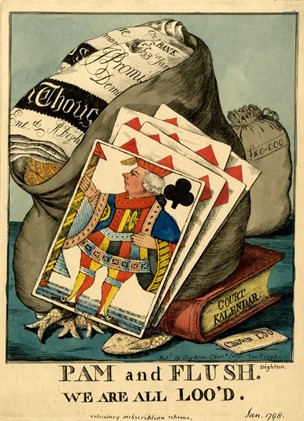
Lanterloo or Loo is a 17th-century trick taking game of the trump family of which many varieties are recorded. It belongs to a line of card games whose members include Nap, Euchre, Rams, Hombre, and Maw. It is considered a modification of the game of "All Fours", another English game possibly of Dutch origin, in which the players replenish their hands after each round by drawing each fresh new cards from the pack.
Phat is an English trick-taking partnership card game descended from the 17th century game of All Fours. It is closely related to the British and Irish game of Don and may have been derived from it during the First World War. Phat is still played in England in Herefordshire, Cheshire, Staffordshire, Norfolk and Suffolk. In Scotland it is known around Motherwell and Wishaw.
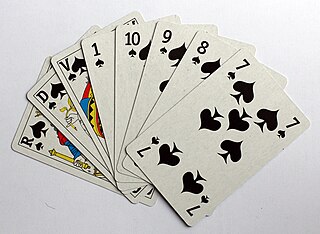
Triomphe, once known as French ruff, is a card game dating from the late 15th century. It most likely originated in France or Spain and later spread to the rest of Europe. When the game arrived in Italy, it shared a similar name with the pre-existing game and deck known as trionfi; probably resulting in the latter becoming renamed as Tarocchi (tarot). While trionfi has a fifth suit that acts as permanent trumps, triomphe randomly selects one of the existing four suits as trumps. Another common feature of this game is the robbing of the stock. Triomphe became so popular that during the 16th century the earlier game of trionfi was gradually renamed tarocchi, tarot, or tarock. This game is the origin of the English word "trump" and is the ancestor of many trick-taking games like Euchre and Whist. The earliest known description of Triomphe was of a point-trick game, perhaps one of the earliest of its type; later, the name was applied to a plain-trick game.
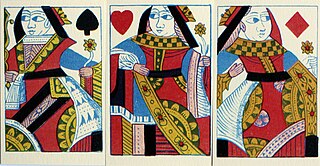
Gleek is an English card game for three people. It is played with a 44-card pack and was popular from the 16th century through the 18th century.
The Compleat Gamester, first published in 1674, is one of the earliest known English-language games compendia. It was published anonymously, but later attributed to Charles Cotton (1630–1687). Further editions appeared in the period up to 1754 before it was eclipsed by Mr. Hoyle's Games by Edmond Hoyle (1672–1769).

Bone-Ace or Bon Ace is an historical English gambling game using playing cards for seven or eight players that appears related to Thirty-One.

Penneech or Peneech, sometimes called Penicth, is an unusual historical English card game for two players played with hands of seven cards. English point-trick games are rare anyway, but the unique feature of this game is that the trump suit changes with each trick. Parlett describes it as a "jolly little two-hander".
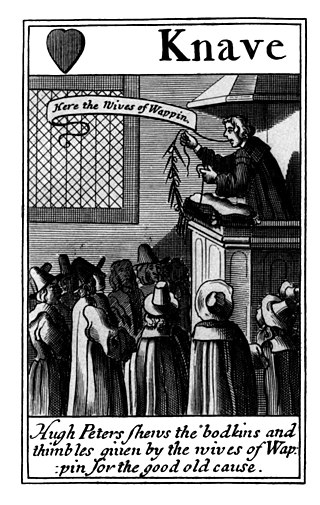
Costly Colours, sometimes just called Costly, is an historical English card game for two players and a "fascinating relative of cribbage". The game "requires a moderate amount of skill in playing, and is well adapted to teach quickness in counting". It has more combinations than cribbage and retains the original scoring system for points, but does not use a 'crib'. In the 19th century it was described as "peculiar to Shropshire."

Queen Nazarene or Queen Nazareen is an old English card game recorded by Charles Cotton as early as 1674. It is an ancestor of Newmarket.

Doublets or queen's game is an historical English tables game for two people which was popular in the 17th and 18th centuries. Although played on a board similar to that now used for backgammon, it is a simple game of hazard bearing little resemblance to backgammon. Very similar games were played in mainland Europe, the earliest recorded dating to the 14th century.


















